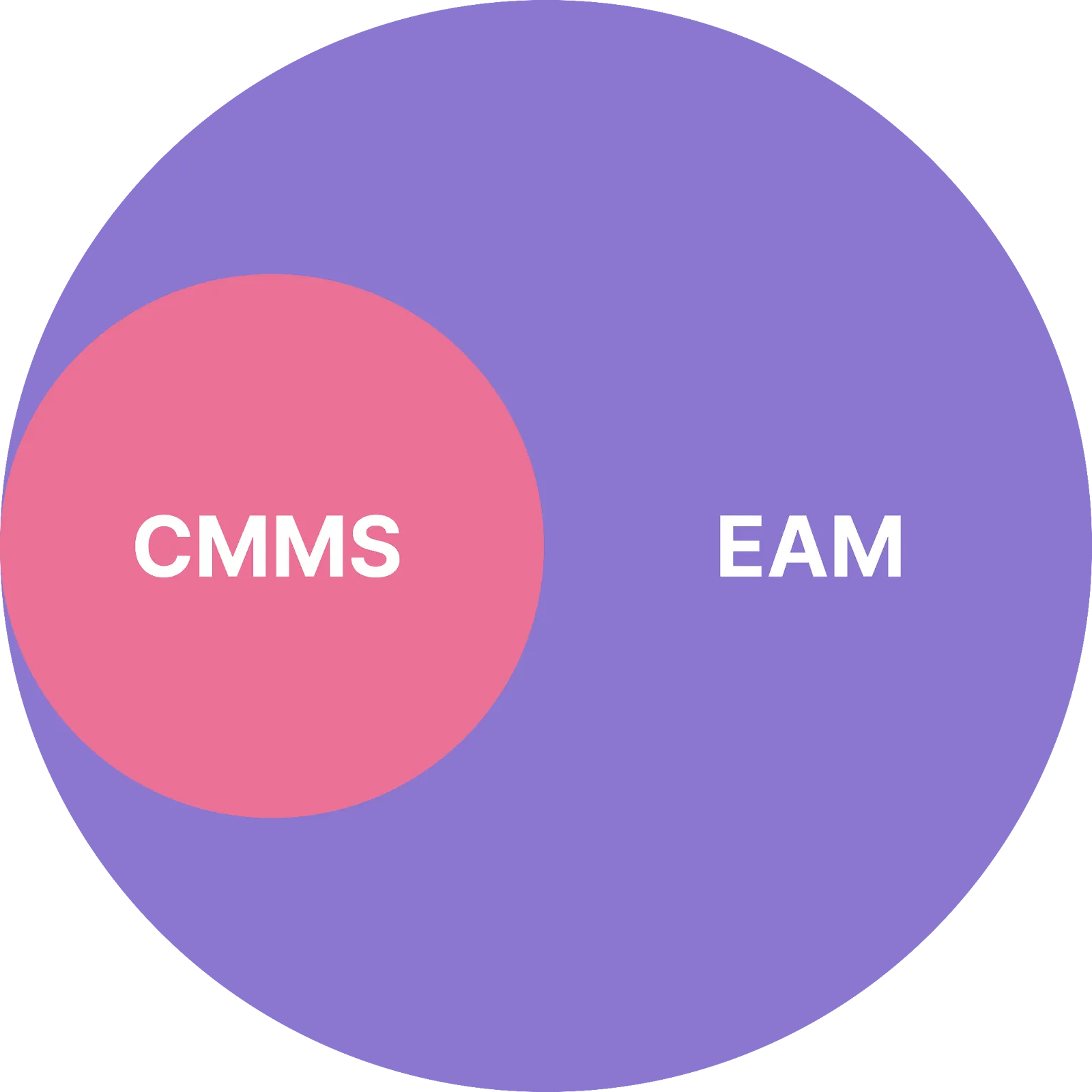Industrial world is full of not-so-friendly abbreviations. We often hear companies get confused between CMMS (Computerized Maintenance Management System) and EAM (Enterprise Asset Management). Are they the same? Is one better than another?
While both platforms are designed to enhance efficiency by managing physical assets and maintenance operations better, they serve different scopes and offer unique functionalities. Understanding the key differences between CMMS and EAM, along with their specific features, can help businesses make an informed decision tailored to their operational needs.
In this article we aim to unravel differences between CMMS and EAM, and to provide clarity on which system aligns best with your company's objectives.
Understanding CMMS and EAM
What is CMMS?
CMMS, or Computerized Maintenance Management System, is a software tool designed to manage maintenance of physical assets. At its core, CMMS focuses on asset uptime and ensuring efficient maintenance operations.
It does work order management, schedules preventive maintenance jobs, accounts for inventory of spare parts. Importantly, it centralizing maintenance data. Using this data CMMS helps organizations reduce unplanned downtime, lower repair costs, and extend the lifespan of their assets. Maintenance teams can track work orders in real-time, manage resources effectively, and gain visibility into inventory levels.
CMMS is particularly beneficial for industries where maintaining equipment and machinery is crucial to operational success and safety.
Many organizations also integrate their CMMS tools with other systems, like ERP systems for procurement of spare parts, or IoT solutions which use sensor readings to trigger maintenance tasks and inspections based on thresholds or historical trends. Historically it has requires a lot of heavy lifting having to involve the CMMS provider and system integrator consultants but modern API tools make it relatively easy.
What is EAM?
EAM, or Enterprise Asset Management, is a comprehensive software solution designed to manage the entire lifecycle of an organization’s assets.
Unlike CMMS, which focuses primarily on maintenance, EAM covers a broader spectrum including asset planning, procurement, installation, maintenance, and disposal. Its features extend to capital planning, compliance management, and risk management, providing a holistic view of asset performance and profitability.
EAM systems enable businesses to link asset uptime with profitability, manage asset depreciation, and optimize asset utilization. This makes it particularly valuable for larger asset-intensive organizations that require detailed oversight over physical assets and strategic planning. Overall, EAM aims to maximize asset value and operational efficiency throughout the asset's lifecycle.
Just like CMMS, EAM systems are often integrated with other systems to support decision-making at multiple organizational levels: from maintenance teams to C-suite executives. The scope of integrations is usually broader too as it is not only about procurement or asset management, but also about financial aspects of managing assets.
We have already established that asset lifecycle management and asset profitability are strengths of EAM solutions over CMMS. For many, however, it may be hard to understand what does this actually mean as they do sound somewhat generic. For that purpose we will dive deeper into both in the following two sections. If you already know what it means, feel free to skip to key differences.
Asset Lifecycle Management
One area where EAM systems stands out from CMMS solutions is asset lifecycle management.
CMMS primarily handles the maintenance phase of an asset's life, focusing on ensuring that equipment remains operational through effective maintenance practices. This includes scheduling preventive maintenance, managing work orders, and tracking inventory levels.
EAM, on the other hand, encompasses the entire asset life cycle - from planning and procurement to operation, maintenance, and disposal. EAM systems offer advanced features like capital planning and asset procurement, enabling organizations to make informed decisions about asset investments. They also track asset installation, compliance, and risk management, providing a comprehensive view of asset performance over time. EAM helps organizations maximize the value of their assets by linking asset uptime with profitability and managing depreciation effectively. This holistic approach to asset management ensures that assets are utilized optimally throughout their entire lifespan, making EAM a superior choice for larger, asset-intensive businesses.
Linking Asset Uptime with Profitability
Linking asset uptime with profitability is a key feature that sets EAM systems apart from CMMS. This is particularly important for organizations where physical assets are linked directly to the revenue.
While CMMS focuses on maintaining asset uptime to prevent downtime and extend the life of equipment, EAM goes further by analyzing how asset performance impacts the overall profitability of the organization. EAM systems provide tools to measure and optimize asset utilization, ensuring that each asset contributes effectively to the company's bottom line.
By integrating financial data with maintenance and operational data, EAM systems can offer insights into the cost-effectiveness of asset operations. This includes tracking the costs associated with maintenance, repairs, and downtime, and comparing them against the revenue generated by the asset. Such detailed analysis helps organizations make informed decisions about asset investments, replacements, and disposals. Ultimately, linking asset uptime with profitability allows businesses to maximize the return on their asset investments, driving operational efficiency and financial performance.
Key Differences Between CMMS and EAM

CMMS excels in work order management, preventive maintenance, and real-time tracking of maintenance activities. EAM, however, offers all the functionalities of a CMMS and then some.
If all you are looking to implement is an effective maintenance management process, a CMMS is likely to be sufficient. In the end of the day, EAM-specific features do come with a price tag. If you are not planning to use it in foreseeable future, it will be an underutilized asset, if you will ;)
If you, however, are looking to maximize asset value from purchase through disposal with comprehensive risk, performance, utilization, and depreciation management, an EAM is more appropriate. One factor to consider here is vendor lock-in as you would depend on one software provider for a broad set of features. This will typically result in high switching costs should you want to move to another provider in future.
Another nuance which is often overlooked or under-appreciated is CMMS products typically have a better user experience with all things maintenance for the staff on site, many come with mobile apps. What makes it important is better user experience reduces the impact of human factor and results in better maintenance data which can drive further initiatives. This doesn't mean that all EAM products have a bad user experience for maintenance operations. Furthermore, many EAM products even used to be a CMMS first, but it does come with a premium.
It is also not uncommon for organizations to use both: EAM for effective asset lifecycle management, and CMMS for great maintenance operations. Doing so organizations can have the best-in-class solution for both and modern API tools can seamlessly integrate the two.
There are many organizations who are looking to extract value from effective maintenance operations first, and then look at asset lifecycle and performance too. In this case it is not a bad idea to start with a CMMS first, and add and integrate EAM later. This will maximize return from the software purchase. More importantly, it will result in a more flexible stack where you can replace CMMS and EAM independently so you can be sure you always run on modern software and are in a stronger position when negotiating renewals with EAM providers.
Conclusion
Choosing between a CMMS and an EAM system hinges on your organization's specific needs and operational scope.
CMMS is ideal for businesses focused on maintaining asset uptime and efficiency through streamlined maintenance processes. It offers robust features and typically a better user experience for managing work orders, scheduling preventive maintenance, and controlling inventory. It is also likely to come at a lower cost.
Conversely, EAM provides a broader, more comprehensive asset management solution that encompasses the entire asset lifecycle. With additional functionalities such as capital planning, compliance management, and profitability analysis, EAM is suited for larger enterprises with complex asset portfolios.
Understanding the key differences and capabilities of each system can guide your decision-making process, ensuring that you select the solution that best aligns with your business objectives. Ultimately, both CMMS and EAM serve to enhance operational efficiency and asset performance, but the choice depends on the breadth and depth of asset management required by your organization.







.jpg)










